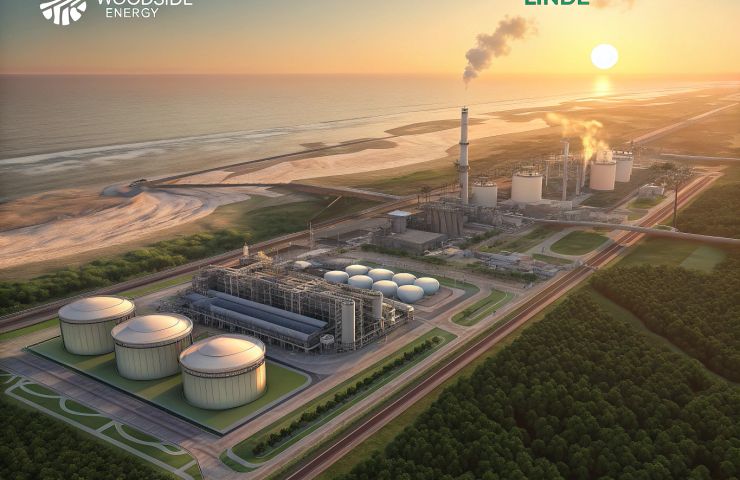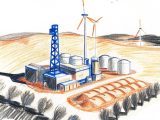
Lower-Carbon Ammonia in Beaumont: Woodside Leads the Charge
October 2, 2025Beaumont, Texas, is stirring up a fresh kind of energy excitement right on the Gulf Coast. Usually pegged as an oil-refinery and petrochemical town of about 117,000 folks, it’s now on track to become a lower-carbon ammonia powerhouse. Last September, Woodside Energy stepped in and took over OCI Global’s Beaumont New Ammonia Project, and guess what? It’s already 90% wrapped up. Phase 1 is slated to kick off in late 2025, and you can almost hear the compressors and reformers gearing up. This isn’t some run-of-the-mill facility—it’s a genuine game-changer in industrial decarbonization, with Woodside right at the forefront of the clean ammonia surge. Once it’s humming, it’ll churn out 1.1 million tonnes a year, serving everything from fertilizers to ship fuel, just in time for market predictions that see the clean ammonia market more than doubling by mid-century.
Powering Global Demand with Clean Ammonia
Right now, we’re using about 180 million tonnes of ammonia worldwide every year, almost all of it for fertilizer. But here’s the kicker: ammonia’s low-carbon profile is opening new doors in power plants and shipping, potentially slashing greenhouse gases by up to 90% compared to standard fuels. Beaumont’s Phase 1 will feed 1.1 million tonnes annually—enough to fertilize roughly 60 million acres or keep 200 ammonia-fueled cargo ships rolling. By trapping the CO₂ produced during hydrogen making, this facility is set to deliver blue ammonia with at least a 50% smaller emissions footprint than traditional methods. Once full-on carbon capture and storage is up and running, we’re talking about offsetting over 2 million tonnes of CO₂ each year, shipping to customers in Europe and Asia straight from local ports. For Woodside Energy, it’s a smart strategic move—they forecast ammonia demand in shipping exploding from almost zero to over 15 million tonnes by 2030, and Beaumont gives them first dibs.
World-Class Partnerships Fuel the Project
You can’t pull off something this massive alone. Woodside Energy tapped into OCI Global’s engineering chops to keep construction and commissioning on point, building in room for future growth. Then there’s Mitsubishi Heavy Industries Compressor International, which delivered three heavy-duty compressor trains and steam turbines—key for keeping everything humming non-stop. ExxonMobil will handle the CO₂ capture and permanent sequestration from the hydrogen unit, leveraging its Gulf Coast storage network. And by 2026, Linde steps in to run the adjoining hydrogen plant, pumping over 200,000 tonnes of lower-carbon hydrogen into the ammonia loop each year. With the site already 90% mechanically complete, commissioning is ramping up just as planned. As Meg O’Neill, Woodside’s CEO, puts it: “This is what teamwork looks like—and a roadmap for tomorrow’s energy projects.”
Innovative Technologies at Scale
At the heart of Beaumont’s success is autothermal reforming, a slick process that mixes natural gas, steam, and oxygen in one go to crank out hydrogen and CO₂. ATR is perfect for pairing with carbon capture and storage, hitting capture rates north of 90%. Once it’s caught, CO₂ zips through pipelines to deep underground formations beneath the Gulf Coast—technology that’s been safe and sound for decades. High-efficiency compressors and steam turbines keep syngas pressure just right for the Haber-Bosch cycle, powering multi-million-tonne runs without missing a beat. By marrying these steps, the plant avoids the energy drag you usually see when reforming and capture happen separately, cutting operating costs and shrinking its environmental footprint—vital for making blue ammonia a commercially viable player. Plus, this seamless setup ditches the usual hiccups, keeping energy use in check and the bottom line solid for lower-carbon ammonia production.
Regional Momentum and Economic Lift
Beaumont’s long history as an oil and chemical hub is paying off big time. With deepwater port access and a thick web of pipelines, it’s primed to export to Europe and Asia. Local suppliers—from steel shops to logistics outfits—are cashing in on multi-million-dollar contracts. At peak construction, the project brings in over 500 workers, and once up and running, it’ll keep about 100 full-time roles humming. Plus, with refineries and skilled trades already on the doorstep, shifting to clean ammonia production feels like a natural next step for the community. Woodside Energy expects the plant to crank out free cash flow by 2026, helping the company hit its Scope 3 emissions targets while giving the local economy a real boost. It’s a win-win: green energy that pays dividends for investors and communities alike.
Impact Today and a Glimpse into Tomorrow
When Beaumont fires up its ATR units late in 2025, 1.1 million tonnes of lower-carbon ammonia will roll off the docks every year. And that’s just Phase 1—Phase 2 could double output to 2.2 Mtpa, cementing Beaumont’s spot as a global blue ammonia export hub. Woodside Energy’s eyeing free-cash-flow positivity from 2026 onward, funneling profits into more low-carbon ventures. While the exact carbon abatement—think around 1.6 Mtpa CO₂-e—hinges on the final make-up of carbon capture and storage and hydrogen operations, early models suggest a carbon intensity cut of up to 50% over conventional plants. More broadly, Beaumont’s success is sending shockwaves through energy markets, proving that large-scale industrial decarbonization is more than just talk. It’s a blueprint for future ammonia hubs along the U.S. Gulf Coast and beyond, and it supercharges demand for clean ammonia in both shipping and power. Already, policymakers and other energy players are circling, eager to adapt Beaumont’s blueprint for their own carbon capture and storage strategies. In a nutshell, this project isn’t just another plant—it’s a sneak peek at the future of energy, where big ideas and technology come together to tackle climate change head-on.



 With over 15 years of reporting hydrogen news, we are your premier source for the latest updates and insights in hydrogen and renewable energy.
With over 15 years of reporting hydrogen news, we are your premier source for the latest updates and insights in hydrogen and renewable energy.